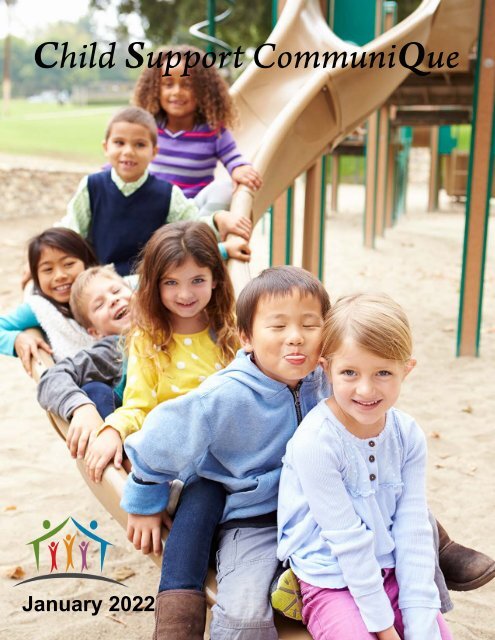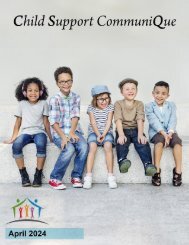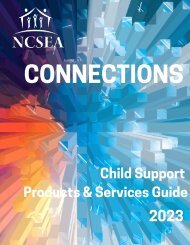January 2022 CSQ
You also want an ePaper? Increase the reach of your titles
YUMPU automatically turns print PDFs into web optimized ePapers that Google loves.
ChildSupportCommuniQue
Table of Contents<br />
<strong>January</strong> <strong>2022</strong><br />
Executive Director’s Message……………………………………………………….… 3<br />
Community Corner: PEP Pressure in a Pandemic Environment…………….………..5<br />
NCSEA <strong>2022</strong> Policy Forum Preview…………………………………………….…........7<br />
A Guided Tour of IV-D Videos and Live Interaction…………………………….……..10<br />
Intergovernmental Hot Topics …………………………………………………………..19<br />
NCSEA U Spotlight……………………………………………………………………….27<br />
Don’t Stand Up If You’re Not Wearing Pants……………………………………….....29
Ann Marie Ruskin<br />
NCSEA Executive Director<br />
As 2021 came to a close, I was determined to focus post-pandemic,<br />
looking beyond the limitations and challenges we have lived for almost<br />
two years. But alas, here we are dealing with the new omicron variant,<br />
and again we are adjusting to current conditions. I am very pleased that<br />
NCSEA will be in-person in Washington, D.C. next month for the Policy<br />
Forum. We have missed opportunities to exchange and interact in<br />
person. So much of our conference experience is engagement with<br />
others outside the scheduled agenda—over breakfast, catching a snack<br />
during a break, a chance meeting waiting for the elevator, or having a<br />
drink at the bar in the evening. It is those spontaneous interactions that<br />
allow us to expand our professional network, meet new colleagues, and<br />
learn more about other State, County, and Tribal programs.<br />
While we’ve missed the in-person events, the pandemic has also<br />
required us to think outside the box, rethinking how we engage our<br />
members, share content, and interact virtually. With that in mind,<br />
NCSEA introduced new initiatives such as the Idea Exchange,<br />
expanded current programs such as NCSEA Connects, and introduced<br />
virtual conference options. The upcoming Policy Forum is an example of<br />
the new opportunity, providing a virtual and in-person option for<br />
attendees. It’s the first time we are offering live streaming in addition to<br />
the live, in-person event, and is introducing a new audience to the<br />
Policy Forum, a unique conference. If you are not able to join us in<br />
person in Washington, D.C., please consider virtual attendance.<br />
Sessions will be live, and recordings posted shortly after the session.
In addition to the Policy Forum, we hope you will take advantage of our<br />
extensive Web-Talk schedule, NCSEA Connects meet-ups for specific<br />
categories of child support professionals, Idea Exchanges, and of<br />
course, the <strong>2022</strong> Leadership Symposium, to be held in August in<br />
Charlotte, North Carolina. We are proud to offer a variety of events and<br />
programs designed to enhance your professional development and<br />
networking and provide important services to the child support<br />
community.<br />
As <strong>2022</strong> begins, we wish all our members and families a very happy<br />
and healthy new year. It is a pleasure working with all of you.<br />
Ann Marie Ruskin has served as NCSEA’s Executive Director since <strong>January</strong>, 2018.<br />
She first joined NCSEA in 2010, leading professional development and programs.
PEP Pressure in a Pandemic<br />
Environment<br />
by John Hurst, Georgia Division of<br />
Child Support Services<br />
At 11:59:59 p.m. on September 30, 2020, Federal Fiscal Year 2020 (FFY<br />
2020) ended. In the child support community, this date marks the end of<br />
the reporting period for annual performance. Normally this is a routine<br />
event for states; however, not much about FFY 2020 was routine due to the<br />
onset of the COVID-19 pandemic in March 2020.<br />
For many states that typically perform well in paternity establishment<br />
percentage (PEP), the restrictions to in-person activities brought on by the<br />
pandemic resulted in states not reaching the 90% federal benchmark for<br />
this performance requirement. In Georgia, we finished FFY 2020 with an<br />
84.11% PEP, which meant we needed to finish FFY 2021 at 86.11% or<br />
higher to avoid a 1% to 2% penalty to our TANF block grant.<br />
I had two major challenges awaiting me when I became Georgia’s IV-D<br />
director in December 2020: the ongoing pandemic and the potential penalty<br />
if we did not improve our PEP by at least 2% in FFY 2021. Our agency was<br />
very responsive at the onset of the pandemic and had implemented<br />
temporary operating procedures that enabled us to continue to provide<br />
services while keeping our customers and employees safe. Obtaining the<br />
2% PEP increase as the pandemic continued through FFY 2021 was a<br />
daunting target that would require an “all hands on deck” effort from our<br />
team.<br />
It was clear that the challenge we had in front of us had captured the<br />
attention of our department commissioner and her team. The support we<br />
received from them was helpful, as it enabled us to tap into some<br />
resources for assistance that we may not have otherwise been able to
access. We received help from the Administrative Office of the Courts,<br />
Council of Superior Court Judges, Office of State Administrative Hearings,<br />
and Attorney General’s Office in spreading the word and putting short-term<br />
processes in place to drive paternity.<br />
After a year of intense focus,<br />
monitoring, projecting, brainstorming,<br />
worrying, and outstanding performance<br />
by our team, I am happy to say that as<br />
of 11:59:59 p.m. on September 30,<br />
2021, our PEP was 87.95%. This is a<br />
3.84% increase over FFY 2020. This is<br />
both good news and bad news. While<br />
we improved by more than the required<br />
2% threshold to avoid a potential penalty, we are still under 90% and must<br />
go through this process again this year as the pandemic continues.<br />
There may be relief to this pressure soon. On October 19, 2021, the<br />
Paternity Establishment Percentage Performance Relief Notice of<br />
Proposed Rulemaking was published, which proposed to modify the PEP<br />
requirement from the 90% performance threshold to 50% for FFY 2020 and<br />
2021 for a state to avoid a financial penalty. The adoption of this proposed<br />
rule would bring much-needed relief to many states that have shared the<br />
same experience as my state in the last year.<br />
John Hurst is the Asst. Deputy Commissioner, Georgia Dept. of Human Services. He<br />
has more than 28 years in the child support program, serving in various roles. John was<br />
appointed to his current position and in this role, he serves as the IV-D Director of the<br />
Georgia DCSS program. John earned a Bachelor of Business Administration degree in<br />
Management from Georgia State University.
<strong>2022</strong> Policy Forum Preview: Focusing On Our<br />
Vision…Recognizing Our Perspectives<br />
by Margot Bean and Connie Chesnik<br />
Co-chairs, NCSEA <strong>2022</strong> Policy Forum<br />
Child Support and Human Service professionals from across the country<br />
will come together in person this February for the <strong>2022</strong> NCSEA Policy<br />
Forum. This year’s theme, Focusing On Our Vision – Recognizing Our<br />
Perspectives, reflects our shared vision that every child receives reliable<br />
financial and emotional support. Over the course of three days, we will<br />
focus our perspectives—no matter how different—to work together on<br />
behalf of children and families and to advance and promote best practices<br />
in the child support program.<br />
Ten plenary sessions will offer attendees a variety of perspectives on topics<br />
trending in the child support community. Additionally, as we continue to<br />
“think big,” attendees will see short videos from several think tanks that<br />
perform child support-related research and advocacy, discussing their<br />
experiences building the child support program and their insights into the<br />
program’s evolution.<br />
Thursday’s sessions will open with a parents’ panel that will enhance<br />
attendees’ understanding of how parents experience services across<br />
human service programs and how we can better align those services to<br />
serve young families more effectively. Participants will also hear from
program leadership on how they are approaching change in their states to<br />
better promote customer participation and engagement.<br />
The <strong>2022</strong> Policy Forum will build on the diversity, equity, and inclusion<br />
(DEI) work begun during last year’s Policy Forum with a session that will<br />
challenge participants to “live what we are learning.” As attendees sharpen<br />
their equity lens, they will also have the opportunity to review existing child<br />
support policies from a domestic violence perspective with a session that<br />
focuses on incorporating trauma-informed practices into our service<br />
delivery.<br />
Friday’s plenaries will open with a session that focuses our perspectives on<br />
how we measure our program’s success. As the child support program<br />
evolves to center families in our discussions and to incorporate DEI and<br />
trauma-informed care principles, a panel of child support program leaders<br />
will explore how performance measures can evaluate the program’s<br />
success in these areas. The remainder of the day will focus on a variety of<br />
operational aspects of the child support program, beginning with the<br />
evolution of child support enforcement tools over time. This session will<br />
feature panelists with different perspectives on enforcement remedies and<br />
how their approaches have evolved to adapt to changes in the program.<br />
Friday’s program will examine the evolution of policy related to paternity<br />
establishment over the past century with a focus on current issues,<br />
including mandatory genetic testing and the implications of paternity<br />
policies on the LGBTQ+ population. This will be followed by a critical<br />
examination of whether recent changes to state child support guideline<br />
requirements have improved child support outcomes for low-income<br />
families. The day will conclude with a discussion of intergovernmental hot<br />
topics, including interstate payment processing, case closure regulations,<br />
$0 orders, limited services, and more. A panel of experts will explore these<br />
topics to identify possible recommendations for change.<br />
You will not want to miss the final programs on Saturday morning. The day<br />
opens with a focus on system modernization, a key component in the<br />
evolution of the child support program. Representatives from states with<br />
recent experiences in modernizing their systems will discuss how to build<br />
systems that can adapt to changes in both policy and customer needs.<br />
The <strong>2022</strong> NCSEA Policy Forum will conclude with an interactive session<br />
designed to bring our different perspectives together to provide actionable<br />
steps attendees can take back to their states to continue working toward
our shared vision. We look forward to reconnecting with you in Washington,<br />
D.C., from February 3-5, <strong>2022</strong>!<br />
Margot Bean is a Managing Director in Deloitte Consulting’s Human Services<br />
Transformation Practice, focusing on helping child support programs improve their<br />
outcomes by providing effective and efficient data driven customer-focused services.<br />
She helps child support programs develop human centered case management systems<br />
that streamline business processes, effectively analyze their caseloads, and allow case<br />
managers to execute case strategies based on customer needs. Margot’s wide variety<br />
of government experience prior to joining Deloitte provides her with deep understanding<br />
and insight: Commissioner of the federal Office of Child Support Enforcement, IV-D<br />
Director of the New York State Child Support program, IV-D Director of the Guam Child<br />
Support Program, and child support attorney. She is a current member of the NCSEA<br />
Board of Directors.<br />
Connie M. Chesnik received both her undergraduate and law degrees from the<br />
University of Wisconsin-Madison. As an attorney for the Wisconsin Department of<br />
Workforce Development, Connie advised the child support program for many years and<br />
has spoken frequently on Wisconsin’s child support guidelines and Wisconsin’s tribal IV-<br />
D program. She is currently the Administrator of the Division of Family and Economic<br />
Security in the Department of Children and Families where she oversees Wisconsin’s<br />
child support, refugee and employment programs. Connie is a member of the State Bar<br />
of Wisconsin, and the State and National Child Support Enforcement Associations. She<br />
currently serves on the NCSEA Board of Directors.
A Guided Tour of<br />
IV-D Videos and Live<br />
Interaction<br />
by Christopher Breen, Massachusetts CSD &<br />
Mary Ann Wellbank, Mary Ann Wellbank, LLC<br />
OVERVIEW AND COVID-19<br />
According to an April 2021 report of the U.S. Census Bureau, Computer<br />
and Internet Use in the United States: 2018, 92% of U.S. households had<br />
“at least one type of computer and 85% had a broadband internet<br />
subscription.” A March 2021 survey conducted by the Pew Research<br />
Center found that “85% of Americans say they go online on a daily basis”<br />
and “44% of 18-to 49-year-olds say they go online almost constantly.” Child<br />
support agencies have leveraged these trends by offering more information<br />
and services through their websites.<br />
COVID-19 provided an additional catalyst for IV-D agencies to find new<br />
ways to deliver IV-D services remotely. This led to both a surge in digital<br />
communication and realization that cloud-based services are essential to<br />
engage customers into the future. As of December 2021, most IV-D<br />
services were back on track, although in many cases the method of service<br />
delivery changed permanently because of COVID-19. State websites offer<br />
new services such as self-service portals for customers and colleagues,<br />
online chatbots, centralized email addresses, and text notifications.<br />
In its April 2021 article Social Media Use in 2021, the Pew Research<br />
Center found that 81% of Americans and 95% of adults ages 18-29 say<br />
they use YouTube. A November 2018 Pew study, Many Turn to YouTube<br />
for Children’s Content, News, How-To Lessons, found that 51% of<br />
YouTube users use YouTube to learn new things. Research conducted by
video marketing firm Wyzowl, and frequently cited by news and technical<br />
media, indicates “when asked how they’d most like to learn about a product<br />
or service, 69% said they’d prefer to watch a short video. This compares to<br />
18% who’d rather read a text-based article, website, or post.” While those<br />
statistics do not necessarily translate to clicking on links to governmentcreated<br />
videos on IV-D websites, they do indicate that short, well-produced,<br />
and conspicuous videos can successfully engage customers.<br />
With this information in mind, the authors explored the IV-D websites of the<br />
54 states and territories to identify innovations that agencies incorporated<br />
into their web offerings, with a focus on the use of video to reach<br />
customers. Numerous IV-D programs have uploaded state-produced<br />
videos to their websites or added links to YouTube videos produced by<br />
external partners such as the Office of Child Support (OCSE), fatherhood<br />
programs, and Sesame Street. An increasing number of states maintain<br />
department YouTube channels independent of IV-D websites where video<br />
content is posted. A smaller percentage of states offer live interactions via<br />
telecommunication, discussed later in this article.<br />
The authors’ review consisted of eyeballing and testing links to videos and<br />
reviewing the offerings to see what is out there and what might be of<br />
interest to other states and IV-D agencies. The approach was subjective<br />
and unscientific, but hopefully useful to IV-D agencies that wish to adopt or<br />
compare best practices from other programs.<br />
Subject to the limitations of the review, the observations of the authors are<br />
categorized and summarized below. Links to the websites and videos have<br />
been inserted in this article so that readers can just click a link to view the<br />
content.<br />
INTRODUCTION TO CHILD SUPPORT VIDEOS<br />
The Administration for Children and Families (ACF) has its own YouTube<br />
channel with hundreds of informational videos targeted to health and<br />
human services professionals and consumers of other programs. This<br />
channel contains an OCSE video (in English and Spanish) that is geared<br />
toward IV-D parents and can be linked to state websites:<br />
• What is Child Support?
• ¿Qué es el sustento de menores?<br />
A number of states including Alaska, Arizona, Kentucky, Maryland,<br />
Massachusetts, Michigan, Montana, North Carolina, West Virginia, and<br />
Wisconsin link to this video.<br />
California has an extensive Video Resource Library with an introductory<br />
video and nearly 60 other videos that it maintains on both its social media<br />
pages and on the state website itself. The 60-second videos posted for<br />
customers are particularly effective.<br />
On its Contact Us page, Colorado links to its YouTube account, which<br />
offers a variety of resources to various stakeholders.<br />
Connecticut’s Judicial Branch has a strong YouTube presence with several<br />
videos to assist parents.<br />
Florida links to its YouTube page, which has a video that explains how to<br />
apply for services.<br />
Illinois has several videos on its website under “How-To Videos”, including<br />
an introduction to child support services, paternity establishment,<br />
modifications, license suspension, and parenting plans.<br />
Indiana Department of Child Services has a YouTube presence with videos<br />
on how to apply for, receive, and pay child support and more.<br />
Maryland has a Vimeo channel that includes a second introduction to child<br />
support (in addition to the ACF/OCSE video) and a license suspension<br />
video for noncustodial parents.<br />
New York has a 20-minute YouTube Video, What You Need to Know About<br />
Child Support Hearings and Services in New York State, that provides a
detailed explanation of the hearing process for each type of petition, the<br />
documents to bring, and the services the IV-D program can provide.<br />
At the bottom of its home page, North Dakota has a short video entitled Do<br />
You Need Help with Child Support? It contains some North Dakota specific<br />
references but would be easily adaptable to other states’ programs.<br />
Vermont’s 21-minute video, Overview of the Vermont Office of Child<br />
Support, details services provided by its IV-D program, answers frequently<br />
asked questions, and describes the legal process.<br />
Virginia has text and a pictorial video accompanied by music: Child Support<br />
Without Court - Five Fast Facts about Child Support.<br />
VIDEOS INTRODUCING USEFUL FEATURES, INFORMATION, AND<br />
APPS<br />
Florida has a video explaining its new eServices website.<br />
Georgia’s website links to the GA DHS YouTube page, which contains a<br />
video on its new mobile app, and other videos related to the child support<br />
program.<br />
Massachusetts provides a helpful tutorial that encourages self-service<br />
through its online Case Manager.<br />
Michigan offers a useful video for its customers explaining how to navigate<br />
the MiChild Support site, while also linking to the ACF video through its<br />
MiChildSupport login page.<br />
Montana has text and a video about a new law that allows continued<br />
assistance to a custodial parent responsible for the care of a disabled adult<br />
child.<br />
Louisiana has a video explaining how to use CAFÉ, the Louisiana selfservices<br />
portal.<br />
Ohio’s home page contains a video, Introducing Ohio’s Child Support<br />
Mobile App, along with links to the Apple App Store and Google Play Store<br />
to download the app.
South Carolina’s homepage includes a video, Child Support Portal<br />
Demonstration, to show parents how to use its portal to access case<br />
specific information.<br />
PATERNITY AND PARENTAGE VIDEOS<br />
A number of states have relatively generic, easily adaptable videos on their<br />
websites about paternity acknowledgment, which can serve as prototypes<br />
for other states.<br />
District of Columbia has a video on its site detailing how to acknowledge<br />
paternity for mothers and alleged fathers.<br />
Illinois has two videos explaining the parental acknowledgment of<br />
parentage process, Paternity 101 and How to Establish Paternity. Its How-<br />
To Library also includes videos explaining business activity for obligated<br />
cases such as review and adjustment, license suspension, and bank levy.<br />
Illinois Child Support Services also maintains a YouTube channel that<br />
shares much of this content and some independent content.<br />
Louisiana features several paternity videos on its YouTube page.<br />
Massachusetts has a helpful video in both English and Spanish,<br />
“Establishing Paternity”, that explains the many benefits to the noncustodial<br />
parent, custodial parent, and the dependent in establishing paternity.<br />
Minnesota has a paternity video on its YouTube page at Minnesota<br />
Paternity, and a second video on community engagement with child<br />
support customers at Minnesota Engagement.<br />
Missouri features a video on its department’s YouTube page explaining the<br />
paternity acknowledgment process and free paternity testing.
On its “Establishing Paternity” page, Oregon has a video, Statement of<br />
Rights and Responsibilities, Voluntary Acknowledgment of Paternity, which<br />
is an oral version of the information found on the back of the state’s<br />
Voluntary Acknowledgment Form.<br />
New York hosts a video on YouTube, Acknowledgment of Parentage in<br />
New York. This 11-minute video is also in Spanish and covers natural<br />
reproduction as well as assisted reproduction and surrogacy.<br />
Tennessee’s video offerings include on-line training programs for hospital<br />
and health department staff, VAoP guide for Hospitals, and A Guide for<br />
Health Departments, respectively. There is also an animated parent<br />
education video in English and Spanish for Voluntary Acknowledgment of<br />
Paternity.<br />
Texas has a comprehensive 17-minute video on acknowledging paternity.<br />
Washington’s 5-minute Acknowledgment of Parentage video is in both<br />
English and Spanish. It describes the process while emphasizing the<br />
acknowledgment form is a legal document that comes with consequences.<br />
The video also explains how to get genetic testing and how to deny or<br />
rescind the Acknowledgment of Parentage.<br />
INTERGOVERNMENTAL CHILD SUPPORT<br />
As part of their recent Intergovernmental Case Processing Innovation<br />
Grants, at least two states have posted videos for parents on their<br />
websites:<br />
• On its home page, North Carolina has a 26-minute PowerPoint<br />
presentation, What is An Intergovernmental Child Support Case?,<br />
which explains the process and helps set expectations for parents<br />
who have cases involving anther state, territory, or tribal land.<br />
• Under the heading of “Services>Intergovernmental>Outgoing<br />
Intergovernmental Cases,” North Dakota has two PowerPoint<br />
presentations:<br />
• Intergovernmental Child Support, which provides an overview of<br />
the process when parents live in two different jurisdictions; and<br />
• The Completing Forms video, which discusses the forms that<br />
customers must complete in order to refer a case to another
jurisdiction. Along with the video are sample forms in an e-learning<br />
format for General Testimony and Declaration Establishing<br />
Parentage with text bubbles containing specific section-by-section<br />
instructions. The sample forms would be useful not only for<br />
intergovernmental customers, but also for child support and<br />
customer service professionals to help their customers complete<br />
these complicated federal forms.<br />
With respect to state-tribal intergovernmental cases, the Iowa Child Welfare<br />
Research and Training Project features videos dedicated to<br />
intergovernmental child support with Iowa DHS and its ongoing relationship<br />
with the Meskwaki Nation tribal IV-D program.<br />
MODIFICATION VIDEOS<br />
Massachusetts posted a modification video on its Massachusetts<br />
Department of Revenue YouTube channel (in addition to several other<br />
helpful videos).<br />
Texas has a text-only presentation accompanied by music, Apply for a<br />
Modification, that explains the 8 steps involved in a modification.<br />
PARENTING VIDEOS<br />
On its home page under “Related Resources,” Connecticut links to the<br />
John S. Martinez Fatherhood Initiative, which features a powerful video,<br />
Connecticut Dear Dad, on the importance of paternal engagement with<br />
their children.<br />
Maine’s website links to a YouTube video regarding the HOPE program<br />
that offers resources to parents seeking pathways to employment.
Oregon has links to two videos for parents interested in parenting time:<br />
• Custody and Parenting Time: What's the Difference?; and<br />
• Parenting Plans⎯Why would you want one? (also available in<br />
Spanish)<br />
Texas has a page dedicated to co-parenting with a 22-minute video on the<br />
topic, For Our Children: Learning to Work Together, and a downloadable<br />
sticker calendar for parents and children to plan and track the time spent in<br />
each parent’s home. There is also a 21-minute presentation targeted to<br />
Incarcerated Parents.<br />
TRAINING<br />
The Texas Parenting and Paternity Awareness (p.a.p.a.) curriculum is<br />
designed to be used by schools and other educational and communitybased<br />
organizations to teach young adults about parenting. It is entirely<br />
online and readily accessible to educators as well as the general public. It<br />
encompasses 10 sessions of approximately one-hour duration, and<br />
includes handouts, teacher resources, group activities, workbook<br />
exercises, and videos. See the introductory video, Section 1a-What is<br />
P.A.P.A?, here.<br />
Oklahoma has created Child Support Quest, a learning library for<br />
Oklahoma child support professionals and a way for employees to submit<br />
bright ideas that will improve child support performance, budget savings, or<br />
program efficiencies. Child support workers access information on this site<br />
daily from their offices, court, teleworking from their homes, or while on the<br />
road, and call center employees often direct their customers to the site for<br />
more information. A search for videos on the Quest website reveals a<br />
number of short and useful videos for child support professionals to learn<br />
about pertinent topics.<br />
LIVE FORMS OF ENGAGEMENT<br />
The Delaware IV-D Director answers questions live once monthly on the<br />
Child Support Connection, which is streamed on Facebook for one hour.<br />
Past discussions are posted in the Facebook Video File. Director Mermigos<br />
also has a standing commitment to a radio talk show for an hour each
month. (Note: Many states may not permit readers to access social media.<br />
See the Delaware website for more information.)<br />
Massachusetts is promoting its Virtual Counter. In addition to facilitating<br />
virtual meetings with customers, the Virtual Counter allows IV-D colleagues<br />
to discuss and resolve reciprocal UIFSA cases using Zoom breakout<br />
rooms.<br />
The Mississippi DHS conducts Town Halls that are available on its<br />
YouTube page. This one covers child support.<br />
As of the date this article was written (December 2021), New York offered<br />
an online Employer Conference scheduled for December 8, 2021. The<br />
purpose was to help employers understand their legal obligations and<br />
obtain guidance on topics such as new hire reporting and processing<br />
income withholding and medical support orders.<br />
DISCUSSION<br />
States have generally posted very comprehensive and useful information,<br />
particularly in the areas of intergovernmental and paternity<br />
acknowledgment. Many states also have videos on establishment and<br />
enforcement, which are not covered in this article due to limited space and<br />
less applicability to other states; however, they can be found on state<br />
websites and YouTube channels.<br />
States have also linked to a plethora of outside services that can be useful<br />
to parents with child support cases. In addition to its videos on divorce and<br />
incarceration, Sesame Street in Communities offers a number of clips on<br />
other topics of interest to families. Several states host their own YouTube<br />
channels, which makes it easier for parents to search state-specific videos<br />
rather than the overabundance of videos created by attorneys or angry<br />
parents on how to fight child support.<br />
While visiting the websites, the authors also noted some areas that could<br />
benefit from improvement. For example, some great videos are buried in<br />
state websites or just reside on YouTube without links from webpages, and<br />
there are also some broken and mislabeled links. However, each website is<br />
unique and different, some more comprehensive, or more easily navigable<br />
than others, but all offer practical information for parents and many have
approaches, videos, and information that can be adapted or imitated by<br />
other states.<br />
Christopher Breen is in his 29 th year of child support enforcement, his 18 th in a<br />
managerial capacity. Chris currently serves on multiple NCSEA committees. He is the<br />
Deputy Director for the Northern Region of the Massachusetts Department of<br />
Revenue’s Child Support Enforcement Division. Chris has also acted as project<br />
manager for several significant implementations, including Massachusetts’ recent<br />
Virtual Counter implementation that leverages Zoom breakout rooms to provide online<br />
customer service. He possesses a B.A. from Providence College with a focus in<br />
English, and an M.A. from the University of Massachusetts. Chris previously completed<br />
a certificate program at Suffolk University, as he begins to pursue his M.B.A.<br />
Mary Ann Wellbank is an NCSEA past president, honorary life member, and Kathy<br />
Duggan Memorial Award Recipient. She is also a past president of the National Council<br />
of Child Support Directors (NCCSD), and honorary life member of the Western<br />
Intergovernmental Child Support Engagement Council (WICSEC). Mary Ann is the<br />
longest serving member of the <strong>CSQ</strong> Editorial Committee. She has over 30 years’<br />
experience in the child support program in the public and private sectors beginning with<br />
a decade of service as Montana’s IV-D Director. As president of her company, Mary<br />
Ann Wellbank, LLC, she specializes in consulting, writing, and research.<br />
GO TO NCSEA.ORG<br />
AND LEARN ABOUT NCSEA BENEFITS & RESOURCES
Intergovernmental Hot Topics!<br />
by Rob Velcoff<br />
Intergovernmental Support Services<br />
If you’re one of those rare and special people who considers<br />
intergovernmental child support hot topics—including interstate payment<br />
processing, enforcement of “dead” cases, and $0 orders—exciting, then<br />
read on. This article is for you. At the National Council of Child Support<br />
Directors’ (NCCSD) 2021 conference, a session was held where these<br />
issues and others, including intergovernmental limited services, interest,<br />
and interstate case closure regulations, led to a lively discussion. Many of<br />
these policies are controversial, crying out for change. What specific<br />
changes should be recommended are debatable, and there is not always a<br />
one-size-fits-all answer. Still, solutions often start with discussions detailing<br />
the problem areas. So, let’s start with the following issues.<br />
Interstate Payment Processing<br />
Currently four different types of child support cases with orders, or<br />
accounts, exist. They might be called by different names across<br />
jurisdictions, but they are basically the following:<br />
1. IV-D Cases<br />
2. Non-IV-D Cases<br />
3. Limited Services Payment Forwarding Cases<br />
4. Arrears Balance Accounts<br />
Everyone knows the most common case types, the IV-D and Non-IV-D<br />
cases, so there is no need to provide details about those. The third type is<br />
the Limited Services Payment Forwarding case. As often happens under<br />
these circumstances, the criteria under which this type of case is used<br />
varies greatly across jurisdictions. Limited Services Payment Forwarding<br />
cases occur when the initiating jurisdiction requests payments be<br />
forwarded from the responding jurisdiction’s State Disbursement Unit
(SDU) to their own SDU, and nothing more. While this type of case should<br />
be initiated by the requesting jurisdiction sending a Child Support<br />
Enforcement Transmittal #3 to the Central Registry of the responding<br />
jurisdiction, many states never make such a request, and instead use the<br />
Child Support Enforcement Transmittal #1 - Enforcement (Box 3.A.) to<br />
request the opening of a full IV-D interstate case. This occurs when the<br />
initiating jurisdiction simply wants the responding jurisdiction to enforce the<br />
order and send payments to the initiating jurisdiction. Previously called<br />
Redirection of Payments, this action is now titled “Child Support Agency<br />
Request for Change of Support Payment Location Pursuant to UIFSA §<br />
319.” Again, some states never request a Limited Services Payment<br />
Forwarding case, probably because they do not have the ability to create<br />
such a case on their own system. These jurisdictions have the ability to<br />
create only full IV-D or Non-IV-D cases, not the other two limited types, so<br />
they do not request this limited service from other states.<br />
The fourth type of case is the arrears balance only case. Each jurisdiction<br />
probably has a different name for this type of account. This type of case is<br />
created when a state/territory/tribe had a IV-D case open at one point, but<br />
the case met federal and/or state case closure criteria and was closed. Still,<br />
that jurisdiction had established a child support order that remains ongoing,<br />
so the controlling order state is still required to maintain the official<br />
determination of arrears, regardless of whether or not payments are<br />
directed through their SDU. Even if other states are currently receiving and<br />
disbursing payments, the controlling-order state is required to maintain the<br />
official payment record, including interest if applicable. Therefore, the<br />
disbursing state must periodically inform the controlling-order state of
payments made, and the controlling-order state must maintain the official<br />
payment record. This is outlined in OCSE’s AT-17-07, Interstate Child<br />
Support Payment Processing, and is a must-read for all child support<br />
workers involved in interstate casework. As with Limited Services Payment<br />
Forwarding cases, the majority of states currently do not have the ability to<br />
create this type of accounting system for closed cases.<br />
One should note that AT-17-07 was published four and a half years ago.<br />
One would think that if child support programs wanted to create this type of<br />
accounting, they would have had ample time to do so by now. Also, federal<br />
financial participation is generally not available for this type of case, further<br />
dampening states’ desires to spend the time and resources necessary to<br />
update their systems to do so. That last sentence apparently sums up the<br />
way that many different jurisdictions seem to feel about these last two types<br />
of cases. They have survived since AT-17-07 was published without their<br />
involvement with these types of accounts, so what is the incentive to create<br />
them now? A very limited number of cases exist where this type of scenario<br />
is even applicable. Controlling-order states frequently close their cases with<br />
no official payment record from that point on, and the other states who are<br />
working the case manage just fine. And it appears the majority of states are<br />
operating in this fashion. If they have not created these two limited types of<br />
accounts after all this time, it’s a safe bet to assume they have no intention<br />
of doing so now.<br />
If the majority of states are loath to make<br />
the changes necessary for limited services<br />
payment forwarding cases and arrears<br />
balance only cases, perhaps we really need<br />
to consider changing the requirements for<br />
these types of accounts. The entire concept<br />
that the state that issued the controlling<br />
order must maintain the official payment record is something that came<br />
about during the creation of the 1996 and 2001 versions of UIFSA. Still,<br />
that concept is not found in UIFSA itself, nor is it found in any federal law,<br />
rule, or regulation. It was only added into the official commentary to UIFSA,<br />
which is not officially binding. OCSE took that 20+ year-old concept and<br />
built federal policy around it.<br />
The original idea was a good one, as states would often disagree on the<br />
arrears amounts in their two-state cases, even after comparing payment<br />
histories. So a tie-breaker was needed. If there were an interstate case<br />
between, say, California and Florida, and California had the arrears on the
case at $6,000 but Florida showed the arrears to be $5,000, the best way<br />
to settle things was that the state that issued the controlling order had the<br />
official determination of arrears, and both states were bound by this. So in<br />
the preceding scenario, if the court order was issued by California, the<br />
arrears on the case were officially $6,000 and both states had to use this<br />
amount. This was especially helpful for states that charged interest. This<br />
concept was never meant to require states to keep their cases open<br />
indefinitely, especially in limited form, after federal and state case closure<br />
criteria applied. Controlling-order states should be able to close their cases<br />
under appropriate criteria in CFR § 303.11, and the disbursing state can<br />
then be charged with maintaining the official determination of arrears from<br />
that point on. This would require the creation of an “Arrears Calculator” to<br />
determine other states’ interest rates, which is an extra step, but once such<br />
a tool is created it should be simple enough to maintain and periodically<br />
update. This seems much simpler than having two separate types of<br />
accounts that are seldom (and in many states, never) used.<br />
Enforcement of “Dead” Cases<br />
Child support workers in responding jurisdictions really dislike when they<br />
are asked to register and enforce a child support order from another state<br />
when the noncustodial parent has no income or assets. Workers<br />
understand that the case doesn’t<br />
have to be an easy one: the NCP<br />
can be self-employed, or have<br />
hidden assets or a spotty work<br />
history. Difficult cases can be<br />
successfully managed. However,<br />
if the case was 100%<br />
unenforceable in the state that<br />
issued the order, what makes the<br />
issuing state think that the NCP’s<br />
current state of residence will have any better chance of success in<br />
However, if the case was 100%<br />
unenforceable in the state that issued the<br />
order, what makes the issuing state think<br />
that the NCP’s current state of residence<br />
will have any better chance of success in<br />
enforcing the order at this time?<br />
enforcing the order at this time? If the initiating jurisdiction has a “dead”, or<br />
completely unenforceable case in their state, and they have located the<br />
NCP in another state but no new income or assets were found, should they<br />
attempt to register their child support order in that new jurisdiction for<br />
enforcement?<br />
The easy answer is “no”, why bother? But wait, perhaps there is some logic<br />
to doing so after all. This reasoning comes from the fact that it is not always<br />
clear as to whether an order is enforceable or not. Even if it’s currently
unenforceable, will it be enforceable in the (near) future? The main reason<br />
to register a court order for enforcement in another state is for judicial<br />
remedies. One-state enforcement tools are currently so thorough and allencompassing<br />
that the initiating jurisdiction can do almost all administrative<br />
enforcement that the responding jurisdiction can do. The initiating<br />
jurisdiction can issue an IWO, do federal tax offset, passport denial, most<br />
bank levies, many property executions, the national Driver’s License<br />
Compact, multi-state FIDM, limited services cooperation between states,<br />
multi-state lottery game intercepts, and a myriad of other administrative<br />
enforcement tools that can be done by the controlling-order state without<br />
the need to involve a second state’s child support agency. This means the<br />
main reason to register an order is judicial enforcement by bringing the<br />
NCP into court for contempt. Since the 2016 Final Rule, before this action<br />
can take place, the child support agency is required to prove the NCP has<br />
the ability to pay the support obligation but failed to do so. So, for those<br />
cases where the obligor simply does not have the ability to pay the support<br />
order, there is no logical reason to register that order for enforcement in<br />
their state of residence. Registration of the child support order should only<br />
occur if the NCP has the ability to pay. And if the ability to pay exists, the<br />
administrative enforcement tools at the disposal of the initiating jurisdiction<br />
are generally sufficient for enforcement. Right?<br />
Well, maybe. The obligor’s current state of residence can enforce the order<br />
in ways that the initiating jurisdiction cannot. In addition to judicial<br />
enforcement, some local administrative enforcement tools exist. Location<br />
efforts are easier by the responding jurisdiction. Many employment<br />
programs and similar courses that are local to the NCP must be set up by<br />
his or her in-state jurisdiction. It can be easier to monitor sporadic<br />
employment by a local agency than by one halfway across the country. So<br />
there is no clear and simple answer to this one; it must be a case-by-case<br />
decision. Still, some common sense should be used when determining<br />
whether to register an order in another state for enforcement. The key is<br />
the “enforceability” of the order. If a realistic chance of successful<br />
enforcement exists, then registration is the answer. However, if no<br />
enforcement action can be taken on the case by the registering jurisdiction,<br />
what is the point of wasting everyone’s time and effort and limited<br />
resources in registering an unenforceable order?
$0 Orders<br />
During these difficult economic times, more jurisdictions are establishing<br />
child support orders with a $0 obligation amount. These are not court<br />
orders that do not list a child support obligation or pend the establishment<br />
of a financial amount for a future time. These are not “non-financial” orders.<br />
These are actually child support obligations for zero dollars. Not all states<br />
use this option, as some have minimum wage orders as the lowest support<br />
obligation amount they can establish. Still others have minimum needs of<br />
the child orders. That being said, more courts are establishing $0 court<br />
orders, or are modifying child support obligation amounts to $0 when the<br />
obligor does not have the ability to pay. Can anything be done with these<br />
orders if the case is interstate? Should these cases have been brought into<br />
court in the first place? Aren’t they the same as the “dead cases” discussed<br />
previously?<br />
They are definitely different and serve a purpose. First, parentage<br />
(paternity) may be adjudicated based on the establishment of such an<br />
order. Second, a child support order is created, setting legal terms such as<br />
age of emancipation as well as jurisdiction for future modifications. Medical<br />
support might even be tied to such orders. While establishment of these $0<br />
orders serves many functions, interstate implications should be considered.<br />
Can such an order be registered for enforcement? Technically, yes.<br />
Realistically, these appear to be “dead cases” as previously discussed. It is<br />
doubtful that most states would even accept such orders for registration.<br />
One could argue that these $0 orders should be<br />
registered and monitored for employment<br />
programs or possible future modifications. In<br />
theory, that might work. In reality, this may not be<br />
a good use of limited resources. However, that<br />
would be up to the registering state. Before<br />
attempting to register a $0 order the initiating<br />
jurisdiction should contact the responding<br />
jurisdiction and simply ask them about it.<br />
Communication is the key, as it is in much of the<br />
intergovernmental case-processing world. Is there anything the responding<br />
jurisdiction can do with such an order? Would they even accept the case<br />
for registration in the first place? Is the NCP employable? Is the initiating<br />
jurisdiction registering a third state’s order that the responding jurisdiction<br />
can be asked to modify at a later time? Again, the answer will vary, so it
ends up being a case-by-case decision. A conversation should certainly<br />
take place between the two child support agencies before any type of twostate<br />
action on a $0 order is attempted.<br />
Final note: Additional topics will be covered in a future article. Also, please<br />
remember that all of the suggestions in this article are simply that – ideas<br />
for future consideration. Until and unless these recommendations are<br />
enacted, the existing federal policies should still be followed by all<br />
jurisdictions. These are simply theories for potential upcoming changes and<br />
are definitely not the author’s way of granting permission for anyone to try<br />
to avoid the well-written and thought-out policy guidance scripted by our<br />
OCSE colleagues.<br />
Rob Velcoff is an independent child support consultant with his own agency,<br />
Intergovernmental Support Services. Before starting his own agency, Mr. Velcoff<br />
worked for the New York State Division of Child Support Services for over 30 years. In<br />
May 2011 he became President of the Eastern Regional Interstate Child Support<br />
Association (ERICSA). Mr. Velcoff has received several awards, including ERICSA’s<br />
Felix Infausto Award (President’s Award). An individual member of NCSEA, Mr. Velcoff<br />
received a BS in Criminal Justice from the State University College of New York at<br />
Brockport and an MA in Criminal Justice from the State University of New York at<br />
Albany.
Is NCSEA U For You?<br />
NCSEA U was chartered in 2013 and currently has<br />
more than 135 alumni. NCSEA U provides a unique<br />
premier educational and professional development<br />
opportunity. It is structured for learning leaders in the<br />
child support community, and it complements NCSEA’s<br />
other educational initiatives and strategies. The<br />
program is taught by nationally recognized child<br />
support leaders, offering a variety of informative and<br />
strategic topics. Classes are structured with an<br />
emphasis on group discussions that include work/life balance and best practice initiatives<br />
with real-time work environment scenarios.<br />
Whether for yourself or your staff, NCSEA U offers a transformative learning experience<br />
and is a catalyst for networking opportunities. NCSEA U alumni would love for you to<br />
become a part of this unique group. Because we are proud of NCSEA U, we will be<br />
featuring Alumni in upcoming <strong>CSQ</strong> articles. Their stories will highlight why NCSEA U is for<br />
you.<br />
Meet Our NCSEA U Alumni<br />
Beverly C. Murphy, Esq. - Class 2019<br />
New Jersey Administrative Office of the Courts<br />
Chief of Child Support Client Services<br />
What would you like others to know about NCSEA U?<br />
Provides good networking opportunities with peers from other states who are experiencing similar<br />
challenges.<br />
NCSEA U @ Leadership Symposium focuses on the emerging and learning leader. How do you<br />
define leadership?<br />
Influencing, inspiring, and helping a group of people to act towards achieving a common goal.<br />
Do you have a favorite quote that you refer to periodically?<br />
"Unless you're continually improving your skills, you're quickly becoming irrelevant." Stephen Covey<br />
Do you have a favorite author in the leadership space and/or would you recommend a specific<br />
leadership book? Why?<br />
The Seven Habits of Highly Effective People by Steven R. Covey. An enduring classic that remains relevant<br />
decades after it was first published.
Ashley Dexter - Class 2016<br />
Deloitte Consulting LLP<br />
Senior Specialist<br />
What was the most valuable aspect of the NCSEA U experience?<br />
The most valuable aspect of the NCSEA U experience for me was getting to meet new child support<br />
colleagues from across the country. To this day, I am still friends with many and look forward to visiting with<br />
them at conferences and on committee calls. The networking opportunity is invaluable.<br />
Since attending NCSEA U, what opportunities (personal and professional) have you experienced?<br />
Since attending NCSEA U, I helped initiate and lead the first NCSEA Connects group which has developed<br />
into a sub-committee. I was elected to the NCSEA Board of Directors and asked to co-chair the Leadership<br />
Symposium planning committee three years in a row. Now, I get to give back by co-chairing the NCSEA U<br />
committee in 2021-<strong>2022</strong>. I really see NCSEA U as a launching pad for my NCSEA involvement and growth<br />
throughout the past several years.<br />
What is a key leadership attribute that you appreciate in others? Why? Servant Leadership:<br />
empowering your team because “The company owner doesn't need to win. The best idea does.” John<br />
Maxwell<br />
Stacy Sharon - Class of 2019<br />
Virginia Division of Child Support Enforcement<br />
District Administrator<br />
What would you like others to know about NCSEA U?<br />
This provides an excellent opportunity to expand leadership skills and knowledge through firsthand<br />
experiences shared by child support colleagues throughout the United States.<br />
NCSEA U @ Leadership Symposium focuses on the emerging and learning leader. How do you<br />
define leadership?<br />
The ability to lead a team in a manner that fosters trust, professional growth, commitment, and dedication<br />
for the purpose of achieving a common goal.<br />
Do you believe that attending NCSEA U helped to shape this definition? How or how not?<br />
It did not shape the definition, but it definitely provided ways to accomplish the goal through the shared<br />
experiences and knowledge of accomplished leaders.<br />
Why would you recommend NCSEA U to others?<br />
NCSEA U will stretch you beyond.
Don’t Stand Up if You Aren’t Wearing<br />
Pants and Other Stories Beyond the Pale<br />
by Mary Ann Wellbank, <strong>CSQ</strong> Editorial Committee<br />
When the <strong>CSQ</strong> Editorial Staff put out a call in the Rapid Read for tips and<br />
experiences using videoconferencing, we thought the title, Don’t Stand Up<br />
if You Aren’t Wearing Pants, would encapsulate the most outlandish<br />
experiences NCSEA members had with virtual meetings. Not by a long<br />
shot! Your contributions have exceeded our expectations.<br />
Once it is seen, it cannot be unseen!<br />
Under the category “Yuckiest Moments” are customers who have attended<br />
hearings from their beds or bathrooms. These are true stories from the<br />
child support annals:<br />
“A client showed up on video lying on his bed without a shirt, eating chili<br />
and a grilled cheese sandwich. The judge told him to put a shirt on as it<br />
was a court hearing, and the guy stated he didn’t have to.”<br />
“Last December, one party showed up for a divorce hearing lying in bed<br />
with revealing Christmas PJs.”<br />
“A 35-year-old… father was sitting in the bathroom bare chested. He was<br />
told to put a shirt on to continue. He started yelling for his mommy to get<br />
him a shirt….”<br />
“One of the attendees was using computer for voice and audio and<br />
apparently needed to … go to the bathroom, taking the laptop with him,<br />
without turning off the microphone or camera.”<br />
“Meeting from his bedroom, lying on his bed, with the laptop on his chest,<br />
pillow in plain sight.”
“My workstation is in my bedroom. My husband sat on the bed to change<br />
his clothes and the camera had him in the upper left corner.”<br />
“Enjoyed hearing someone flush the toilet once. Thankfully, I couldn’t hear<br />
what happened prior to the flush. ”<br />
“During a conference, someone had their camera phone with them when<br />
they went to the bathroom… oh what did I<br />
see (and hear)! The messy bathroom with<br />
towels all over the floor. If I wasn’t shocked<br />
about him taking the phone to the potty, I<br />
was shocked at the grown person still<br />
leaving towels on the floor.”<br />
Remember the mute button!<br />
Another frequent and annoying occurrence is failure to correctly use the<br />
mute button.<br />
“A person… started making a fast-food breakfast order without knowing<br />
they weren’t on mute⎯a sausage Egg McMuffin®, hashbrowns, and a<br />
large diet coke meal.”<br />
“During the roughest part of the pandemic, (a) teenager interrupted the<br />
training to ask to go eat lunch outside at the park. The (external) trainer<br />
thought she had muted herself (but didn’t) and ended up lecturing her child<br />
about why it wasn’t safe to be around people at that time. It was awkward<br />
and a train wreck and I couldn’t look away.”<br />
“A person talking to their kids about how to cook eggs when they thought<br />
they were on mute.”<br />
“I was hosting a virtual meeting and thought my sound and video were off<br />
while I was waiting to start the meeting. Wrong! I had been singing with the<br />
radio for about 3 minutes before anyone told me I wasn’t on mute. . . .<br />
Luckily, my video was off because I had been chair dancing, too!”
Pets, Children and Spouses. Oh my!<br />
One individual observed, “Pets, children, and spouses can always be<br />
counted on for the unexpected.” Indeed!<br />
“My Pitbull Terrier tried to get in my lap to see my boss on my computer<br />
screen and knocked me out of my chair.”<br />
“While I was busy listening (and taking notes) during a video call, my cat<br />
jumped up… (and) tapped the web cam cord just enough to move the<br />
camera so it was focused on the stove vent and cupboard above it (vs.<br />
focused on the pretty door behind me).”<br />
“At a Zoom Court hearing, a judicial officer had a green screen (essentially<br />
a green bed sheet) up behind her with her official court seal projected<br />
virtually. In the middle of the hearing, her cat jumped on the sheet and tore<br />
it down making the judicial officer all flustered.… Fortunately, it was just a<br />
blank wall with some family pictures behind that sheet and not her bedroom<br />
or something worse.”<br />
“At the start of the pandemic … whenever my 8-year-old grandson came<br />
into the living room where I would telework, he would easily see that I’d be<br />
on a video call… a year later, COVID restrictions were loosened and my<br />
family and I attended our local county fair … wearing masks was still<br />
required. As we were about to sit down in a large picnic area … my coworker<br />
called out to me. I asked her how she recognized me with a mask<br />
on. She pointed to (my grandson) and said, ‘Your grandson took off his<br />
mask and I recognized him from the times he would pop up in our<br />
meetings.’”<br />
That’s not all, Folks!<br />
Yes, there are more anecdotes, some humorous; others serious.
could see me.”<br />
“I forgot I had my night scarf still on.”<br />
“When we first started using Zoom, I<br />
thought that when the presenter shared the<br />
screen, it meant no one could see each<br />
other. The presenter shared the screen. I<br />
had an evening meeting and I was starved<br />
so started eating a bowl of spaghetti in a<br />
barbaric manner (which I would never do in<br />
public) … I later found out that everyone<br />
“I had a call with a participant who decided to run some errands.… Her<br />
camera clearly showed her driving down the freeway in her car.”<br />
“The NCP thought the (virtual hearing) had ended and he was on with just<br />
the CP, but the case manager was still on the call. The NCP made some<br />
pretty threatening statements about the CP. It caused the case manager to<br />
activate the DV (Domestic Violence) Training and warn the CP about the<br />
comments. The CP had muted the NCP so she didn’t hear what he said.<br />
We were able to get an order of protection.”<br />
Best Practices<br />
Survey respondents suggested best practices for hosts and participants,<br />
summarized below. Video conferencing experts agree.<br />
Host Responsibilities<br />
• Start the meeting on time and admit participants promptly.<br />
• Set up conferences to default to mute. This will help ensure that<br />
unintended audio is not heard by the participants. Participants must<br />
purposely unmute in order to speak.<br />
• Create a virtual seating chart for regular meetings, if available.<br />
Zoom, for example, allows the host to create a fixed seating<br />
configuration. This feature is especially useful for activities that<br />
involve calling on people to speak in a specific order or putting<br />
participants into virtual groups.
• Conduct a roll call from a list. It is easier and takes less time than a<br />
“shout out.”<br />
• Know all the platform’s features and enable those you want to use to<br />
customize the experience.<br />
• Allow time for people to network or use an icebreaker (check out<br />
“MUTE-iny”) to facilitate conversation, and engage people during the<br />
meeting.<br />
• Use the video but forewarn participants so they can prepare to be on<br />
camera. Video conferencing helps people connect, especially when<br />
they work remotely.<br />
• Disseminate an agenda for each meeting and stick to it! Keep the<br />
length⎯and frequency of⎯<br />
meetings manageable. Beware of<br />
video burnout: too many hours a<br />
day in virtual meetings can cause<br />
physical and emotional fatigue.<br />
Schedule breaks.<br />
• If you plan to grant other individuals<br />
permission to present, know how to<br />
share the screen, and verify they know how to give an online<br />
presentation.<br />
• Ask a co-worker to serve as co-pilot when running a large meeting.<br />
• Communicate your expectations and ground rules in advance. This is<br />
especially important for first-timers and parties to hearings. Spend the<br />
first few minutes reviewing the rules and explaining the<br />
teleconferencing features.<br />
Participant (including Host) Responsibilities<br />
• Familiarize yourself with the platform prior to the meeting.<br />
• Test the device’s speakers and microphone before the call and, if<br />
possible, use headphones to minimize external noise.<br />
• Update your name; otherwise, it might default to a previously used<br />
moniker or your device name, e.g., iPhone.<br />
• For video meetings:
• If you use an external camera, position it so that you face it<br />
directly. This can be tricky with dual monitors. Check the<br />
external camera before each video call to ensure it is at eye<br />
level.<br />
• Check the camera angle too so that your whole face is visible,<br />
and that the audience is not looking up your nostrils.<br />
• Your background should be tidy and appropriate. Staging your<br />
area is important to creating a professional image. We’ve all<br />
seen messy rooms, open closets, or, as one colleague<br />
observed, towels all over the bathroom floor! Most platforms<br />
allow participants to blur their screens or add virtual<br />
backgrounds, which are simple solutions, however these<br />
features often cause your on-screen image to quiver. Some<br />
agencies have created their own backgrounds. Other options<br />
are to purchase a green screen or an office-themed backdrop.<br />
Backdrops are inexpensive and clever ways to hide<br />
workspaces that are set up in laundry rooms, garages,<br />
bedrooms, or kitchens.<br />
• Dress for the workplace or court, and make sure you are wellgroomed.<br />
Like it or not, your attire sends a silent, possibly<br />
inaccurate, message about you and your job skills.<br />
• Wear pants! Fishbowl, a semi-anonymous networking app,<br />
conducted a 2020 Coronavirus Survey that revealed nearly 10<br />
percent of people wear only underwear below the belt during<br />
video conference calls! They didn’t ask how many men didn’t<br />
wear shirts, or how many people video-called from the<br />
bathroom, but our own informal NCSEA <strong>CSQ</strong> survey exposes<br />
this practice.<br />
• Safeguard your privacy: avoid displaying items that could reveal<br />
your location or personal information to the public.<br />
• Turn on your camera while speaking.<br />
• Turn off your camera if you encounter issues with bandwidth,<br />
but first turn off your robot vacuum and ask the kids to stop their<br />
video games or streaming.<br />
• Lighting is important. Experts recommend facing a light source<br />
and optimizing natural lighting. To minimize eye glass glare, try
to light your face from the top and the side, and if possible, tilt<br />
your spectacles to avoid reflection of the computer screen.<br />
• Make sure your device battery is plugged in or sufficiently<br />
charged and your computer does not fall asleep!<br />
• Know the rules about eating, drinking, and smoking. In formal<br />
setting, such as hearings or meetings with community<br />
members, drinking water might be okay, but eating is generally<br />
impolite and probably taboo! On the other hand, a snack or<br />
sandwich may be perfectly acceptable for an intra-office<br />
meeting with your peers. Best advice: Investigate before you<br />
masticate!<br />
• If you will be presenting, close all other windows and make sure you<br />
know how to share your screen. This can be particularly challenging if<br />
you have dual monitors. Rehearse your presentation using the<br />
teleconferencing platform so you know which screen to display. Exit<br />
other systems to avoid accidentally disclosing confidential data. Also,<br />
turn off your email so that viewers do not see pop-up messages.<br />
• Be present and remain engaged. Avoid multi-tasking. Some platforms<br />
can detect inattentiveness.<br />
• Ask household members not to interrupt you and post a sign to<br />
remind them. Develop a plan to keep children and pets occupied so<br />
they don’t require your attention during the call.<br />
• Know how to use the mute button and use it when you are not<br />
speaking in order to minimize background noise. Double check it<br />
before you yell at pets or family members or start clicking away on<br />
the keyboard! Remember to unmute as well.<br />
• Use the hand-raising feature, if available, in larger meetings to<br />
indicate you’d like to speak.<br />
• Be careful when using a “chat box” to ensure your conversation is<br />
directed to the right recipient, otherwise it defaults to “everyone.”<br />
• Don’t leave the conference⎯even for a quick break⎯without letting<br />
people know.<br />
• And the best advice of all: Handle mistakes with grace.<br />
Most contributors agreed that video should be on during meetings but be<br />
cognizant of what people are seeing⎯and be mindful of the mute button!
Where to go from here<br />
Thanks to those who shared their best practices and personal experiences<br />
with teleconferencing. They were spot on!<br />
A plethora of useful resources is on the internet as well. Search and you<br />
can find conferencing advice and how-to videos. Suggestions range from<br />
best colors to wear, using meeting rooms, must-have technology,<br />
icebreaker games, closed captioning, live transcription, meeting etiquette,<br />
teambuilding, etc. Let your fingers do the walking!<br />
And, finally, a little poem to convey our wishes for you in <strong>2022</strong>:<br />
May your conferences go smoothly with everyone clothed.<br />
May there be no videos of hairs in your nose.<br />
May the mute button work with flushes suppressed,<br />
And no man present baring his chest.<br />
May the beds be made and the kitchen be clean<br />
With no cluttered background destroying the scene.<br />
No cats, dogs, or kids’ noise to be heard,<br />
And nobody says a disparaging word.<br />
And, if you dread the next video call,<br />
Merely click on “Zoom,” then hit “Uninstall.”<br />
Mary Ann Wellbank is an NCSEA past president, honorary life member, and Kathy<br />
Duggan Memorial Award Recipient. She is also a past president of the National Council<br />
of Child Support Directors (NCCSD), and honorary life member of the Western<br />
Intergovernmental Child Support Engagement Council (WICSEC). Mary Ann is the<br />
longest serving member of the <strong>CSQ</strong> Editorial Committee. She has over 30 yearsexperience<br />
in the child support program in the public and private sectors beginning with<br />
a decade of service as Montana’s IV-D Director. As president of her company, Mary<br />
Ann Wellbank, LLC, she specializes in consulting, writing, and research. She possesses<br />
a B.A. in English and an M.B.A. in finance. Mary Ann and her colleague, Jeff Ball, coauthored<br />
a book, “The Insiders’ Guide to Child Support: How the System Works,” a<br />
valuable resource for parents and child support professionals who need to know the<br />
nuts and bolts of the IV-D program.















